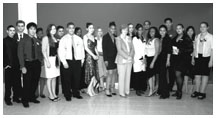Have an opinion about this issue of PAW? Please take a minute to click here and fill out our online questionnaire. It’s an easy way to let the editors know what you like and dislike, and how you think PAW might do better. |
Celebrating the accomplishments of the first graduates of the Princeton University Preparatory Program last spring. |
Opening Doors to Higher Education
In January I attended the beautiful memorial service for Richard B. Fisher ’57 at Riverside Church in New York. The very moving reminiscences of his family and friends told the story of a young boy, stricken with polio at the age of 8, who attended both William Penn Charter School and Princeton on full scholarship. The promise and potential that both institutions saw in this brilliant and determined young student were fully realized as Dick rose to become the chairman of Morgan Stanley and a man who gave with extraordinary generosity both his time and resources to so many educational and cultural institutions, including, of course, his beloved alma mater. Dick served Princeton as a charter trustee from 1984–1994 and chaired the board of PRINCO, our investment company. But what is less well known is that Dick created opportunity for others through his support of financial aid for students both at home and abroad. The four funds associated with his name have generated more than 200 scholarships, reflecting Dick’s conviction that the opportunity for a Princeton education should be available to every qualified student, independent of socio-economic status.
My predecessor, Bill Bowen *58, has argued compellingly that “in American higher education today, the continued— successful—pursuit of excellence depends on opening wider the gates of opportunity.” Unless academia lends its weight to society’s efforts to nurture the talents and broaden the horizons of all children, the pool of candidates on which we draw will be a shallow one, however sparkling its surface.
Education holds the surest key to social and economic mobility, particularly at a time of increasing specialization in employment and competition from abroad. It also ensures that national leadership, broadly defined, does not become the birthright of one class or race or gender. The face of higher education has changed dramatically since World War II, but as Bill reminds us, our work is by no means done. According to figures he has assembled, the probability of both taking the SAT and scoring above 1200 is approximately six times higher for students from America’s top income quartile than it is for students from the bottom quartile. Indeed, the best predictor of SAT scores is now family income. While many factors are responsible for this imbalance, the widening gap between our nation’s richest and poorest public schools is among the most disturbing. In 2001–2002, according to a national study released this fall, school districts with the highest levels of poverty received $868 less per child in local and state support than those with the lowest levels of poverty.
The failure of some public schools to give their students the tools they need to prosper, coupled with the corrosive effects of poverty on families and communities, presents a challenge that we at Princeton must confront, even though we cannot hope to overcome it overnight or on our own. There are a number of things we are doing, however. Thanks to the generosity of alumni, we are leading our peers in finding new ways to lessen the financial burden on students and their families, including our groundbreaking “no-required-loan” policy. The impact of this policy has been palpable: this year and last, 52 percent of our freshmen received financial aid, up from 38 percent just seven years ago, and 7 percent of the last three admitted classes are the first members of their families to attend college.
One of our most important initiatives this year was to increase the amount of time admission officers are on the road, enabling them to visit a wider range of high schools, including many that have not traditionally sent significant numbers of graduates to Princeton. In their meetings with these students, admission officers make every effort to dispel the notion that Princeton is a place where “other” people go and that the cost of a Princeton education is prohibitive.
It is not sufficient, however, merely to identify those rare students who have succeeded against all the odds. We must also be prepared to provide assistance to disadvantaged students well before they graduate from high school. The Princeton University Preparatory Program (PUPP) has given high school students from Princeton, Trenton, and Ewing a unique opportunity to spend three summers on our campus, where the skills and confidence they need to gain admission to selective colleges and universities are developed. Three years ago, when I wrote about this program in these pages, I expressed the hope that some of PUPP’s graduates would return to Princeton. Two have done just that, while their 18 classmates have been admitted to colleges and universities ranging from Columbia to Vassar.
The success of this program is not unique; organizations that share its objectives have helped countless young men and women to realize their potential. Insofar as we can advance the mission of these organizations, we do so, often working with our own alumni: men and women like Raj Vinnakota ’93, co-founder of the SEED School of Washington, D.C., and Melissa Wu ’99, deputy director of New York’s TEAK Fellowship, both of which sent their first graduates to Princeton this year.
Some may worry that these efforts will only increase the number of disappointed
applicants, which is one of the reasons we are expanding the student body
by 11 percent commencing in 2007. But I believe that the alternative—to
limit our search for excellence to schools whose high yields and abundant
resources negate the need for extra effort on our part—would be
far worse, not just for us but for our nation.
![]()


